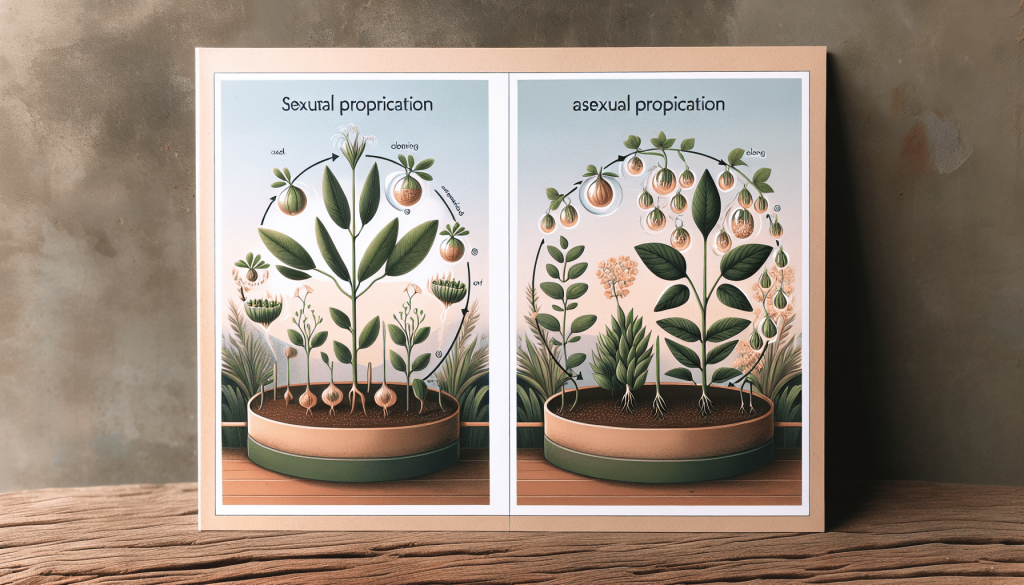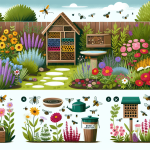This post may contain affiliate links. As an Amazon Associate, we may earn commissions from qualifying purchases.
You’re about to dive into an engaging exploration of plant propagation, a fascinating topic that uncovers how plants reproduce and thrive. In this article, “What Are The Differences Between Sexual And Asexual Plant Propagation? Provide Examples Of Each Method And Discuss Their Advantages And Disadvantages,” you’ll discover the distinct differences between these two reproduction strategies. We’ll explore examples like seed sowing for sexual propagation and cloning through cuttings for asexual propagation. Along the way, you’ll learn about the unique benefits and challenges each method presents, helping you better understand the incredible adaptability and resilience of plants. Have you ever wondered what sets sexual and asexual plant propagation apart? Whether you’re a gardening enthusiast or just looking to broaden your botanical knowledge, understanding these two fundamental methods of plant reproduction can provide valuable insights into how plants grow and thrive. In this friendly guide, we’ll delve into the differences between sexual and asexual plant propagation, provide examples, and discuss the advantages and disadvantages of each method.

Sexual Plant Propagation
Sexual plant propagation involves the combination of genetic material from two parent plants to produce a new individual. This process essentially mirrors the sexual reproduction seen in animals, although with some unique botanical twists.
How It Works
In sexual propagation, male pollen from one plant fertilizes the female ovule of another (or the same) plant, resulting in the formation of seeds. These seeds contain the genetic information from both parent plants and, when planted, grow into new plants.
Examples of Sexual Propagation
- Seed Formation: The classic example of sexual propagation is the formation of seeds in flowering plants. For instance, when you plant a sunflower seed, it has undergone sexual reproduction to develop into a seed.
- Pollination: The process of pollination—by wind, insects, or other agents—enables sexual reproduction. Bees, for example, play a crucial role in enabling the formation of fruits and seeds in many plants by transferring pollen.
Advantages of Sexual Propagation
- Genetic Diversity: Sexual propagation leads to genetic variation, resulting in plants that may be more resilient to diseases and environmental changes.
- Adaptation: The offspring produced through sexual propagation have a higher chance of adapting to different environments, which can be crucial for the survival of species in the wild.
- Evolution: Sexual reproduction drives evolution by combining different traits, leading to potentially superior characteristics in future generations.
Disadvantages of Sexual Propagation
- Time-Consuming: It often takes longer to produce mature plants from seeds than from asexual methods.
- Unpredictability: Seeds can produce plants with unpredictable traits, which might be undesirable for certain agricultural or horticultural purposes.
- Dependency: Successful sexual propagation often depends on external factors like pollinators or specific environmental conditions.
Asexual Plant Propagation
Asexual plant propagation involves creating new plants from parts of a single parent plant, without the need for seeds or genetic contribution from another individual. This method results in offspring genetically identical to the parent plant, known as clones.
How It Works
In asexual propagation, plant structures such as stems, leaves, or roots are used to produce new plants. Techniques such as cuttings, layering, and tissue culture are commonly employed to achieve asexual reproduction.
Examples of Asexual Propagation
- Cuttings: One of the simplest and most common methods, it involves cutting a part of the plant (stem, leaf, or root) and planting it to grow a new plant. For example, many houseplants like pothos or succulents can be easily propagated through cuttings.
- Layering: In this method, a branch or stem is bent to the ground and covered with soil, encouraging it to grow roots. Once the roots develop, the new plant can be separated from the parent. An example is the propagation of blackberry bushes.
- Tissue Culture: Also known as micropropagation, this advanced technique involves growing plants in a sterile environment using small tissue samples. It’s commonly used for orchids and other plants requiring precise conditions to propagate.
Advantages of Asexual Propagation
- Uniformity: Asexual propagation produces genetically identical plants, ensuring uniformity in crops and ornamental plants.
- Speed: Many asexual methods, such as cuttings, result in mature plants more quickly than sexual propagation.
- Predictability: Since the offspring are clones, you can be certain of the traits and characteristics of the new plants.
Disadvantages of Asexual Propagation
- Lack of Genetic Diversity: Asexual reproduction doesn’t introduce new genetic traits, which can make plants more susceptible to diseases or environmental changes.
- Resource Intensive: Some asexual methods, like tissue culture, can be resource-intensive, requiring specialized equipment and expertise.
- High Maintenance: Young plants produced asexually may require more careful nurturing and management compared to those grown from seeds.
Comparing Sexual and Asexual Propagation
To summarize the key differences and make it easier to understand, let’s compare sexual and asexual propagation using the following table:
| Aspect | Sexual Propagation | Asexual Propagation |
|---|---|---|
| Genetic Diversity | High (due to combination of genes) | None (clones of parent plant) |
| Time to Maturity | Longer | Usually faster |
| Predictability | Unpredictable (variable traits) | Predictable (identical traits) |
| Adaptability | Better adaptability to environmental changes | Limited adaptability |
| Resource Requirements | Lower (usually requires seeds and soil) | Can be higher (specialized methods like tissue culture) |
| Maintenance | Generally easier | Can be more demanding |
Practical Applications
Understanding the nuances of sexual and asexual propagation can help you choose the best method for your gardening, horticultural, or agricultural projects. Let’s explore some scenarios where each method might be particularly beneficial.
When to Use Sexual Propagation
Sexual propagation is ideal when you aim to:
- Breed New Varieties: If you’re looking to develop new plant varieties with unique traits, sexual propagation allows for genetic recombination.
- Enhance Diversity: For ecosystems or gardens where genetic diversity is beneficial for resilience and survival, sexual propagation is key.
- Natural Setting: In wild or unmanaged settings, allowing plants to reproduce sexually supports natural ecosystem dynamics.
When to Use Asexual Propagation
Asexual propagation is particularly useful when you want to:
- Ensure Uniformity: In commercial agriculture and horticulture, where consistency in product quality is crucial, asexual propagation ensures uniform crops.
- Quickly Expand Plant Numbers: If you need to rapidly increase the number of plants, such as for landscaping projects or filling garden beds, asexual methods like cuttings or layering are efficient.
- Preserve Specific Traits: For plants with desirable characteristics (e.g., disease resistance, flower color), asexual propagation preserves these traits in new plants.

Practical Tips for Plant Propagation
Regardless of whether you choose sexual or asexual propagation, successful plant reproduction requires some essential techniques and care. Here are a few practical tips to help you get started:
Tips for Sexual Propagation
- Choose Quality Seeds: Start with high-quality seeds from reputable sources to ensure good germination rates and healthy plants.
- Provide Optimal Conditions: Ensure proper soil, moisture, and light conditions for seed germination and seedling growth.
- Manage Pests and Diseases: Protect young plants from pests and diseases which can affect their growth and survival.
Tips for Asexual Propagation
- Use Healthy Parent Plants: Always select healthy and vigorous parent plants for cuttings or other asexual methods.
- Proper Tools and Techniques: Use sharp, clean tools to take cuttings and follow recommended techniques for layering or tissue culture.
- Create a Suitable Environment: Provide the right conditions (e.g., humidity, temperature) for rooting and growth of cuttings or new plants.
Conclusion
By now, you should have a clearer understanding of the differences between sexual and asexual plant propagation, along with practical examples and the advantages and disadvantages of each method. Whether you’re seeking to experiment with different propagation techniques in your garden, improve agricultural productivity, or simply gain insight into the fascinating world of plant biology, these methods offer diverse and valuable tools to nurture and multiply plant life. Happy gardening!








